Devin: What is your superpower?
Evan: Something that I’ve always tried to do—it sort of happened naturally and unconsciously in the beginning of my career, and now I’m a lot more conscious and sort of deliberate about it—but it’s finding the synergies between organizations, between teams, among technologies, among problems. There are not a lot of people that are working on water access in Africa and California. My other day job is I’m a professor of engineering at the University of Colorado in Boulder, and I’m the CEO of this company. I’ve gotten a lot of side-eye about that over the years. My joke is I’m the best academic in a group, in a room of entrepreneurs, and I’m the best entrepreneur in a room of academics. And there’s some truth to that because the corollary is I’m not the best at any one of those things. But by being able to see the benefit of what a university can do and what research can do and what students and faculty can do, but also seeing the benefits of what capital can do, and engineers and technology development and working with nonprofits and working with government—I’ve benefited from being able to see how those things can be aligned with each other and can help solve problems that any one of those kinds of organizations aren’t able to do by themselves.
“My Ph.D. is in aerospace engineering,” Evan Thomas, CEO of Virridy and professor in the Civil, Environmental and Architectural Engineering Department at the University of Colorado. “The beginning of my career was at NASA’s Johnson Space Center in Houston. I worked on water recycling and air quality systems for spacecraft.”
That is not the beginning of most stories about public health. It is a fascinating start to our story today. Evan was the project manager for a system on the International Space Station today measuring recycled water quality.
“The astronauts have to recycle the drinking water every day, and the astronauts in the space station need the same thing we all need,” Evan says. “They need clean water. They need clean air. They need safe sanitation. They need safe food. They need a warm environment. On the space station, we do that through water recycling and scrubbing the air and making sure that the environment is safe.”
“We have those challenges here on Earth, too,” he says. “It’s 2022, and you still have almost half the world’s population, over three and one half billion people who use firewood every day to cook and to stay warm. The use of firewood contributes to deforestation and soil erosion and black soot emissions.”
“But, all of those things are secondary to the immediate emissions that people breathe in every day because of the use of fuels like firewood,” Evan says. “We have almost 5 million kids under the age of five who die every year because of respiratory disease. Still today, we have 2 billion people in the world that don’t have safe sanitation. And most reasonable estimates put it at over a billion people still don’t have access to clean water.”
When Evan launched Virridy while still at NASA, he recognized an essential choice in his life and career. “Am I going to make a career out of being a NASA engineer, or am I going to make a career out of applying that engineering skill to the same basic necessities here on Earth?”
He left NASA to focus on global health.
These days, he focuses his work on two regions of the world: the Horn of Africa and California.
The Horn of Africa
“I’ll tell you a little bit about the Horn of Africa,” Evan says. “This is a very arid region of the world. It includes Somalia and Ethiopia and northern Kenya. We’ve been working in that region for about ten years. I just got back from northern Kenya a few weeks ago, where they’re suffering from a five-season drought. It’s unprecedented.”
“You have 40 million people that are relying on rains, rains for their livestock, for themselves, for their agriculture,” he says. “When you have drought, you have crop failure, you have livestock death, you have the displacement of people. And 40 million people are facing food insecurity right now in East Africa.”
The challenges in East Africa differ from those in California. While aquifers are drying up in California, groundwater reserves are increasing in Africa.
The challenge in Africa is often that water pumps fail due to a lack of resources, so the water isn’t accessible to those who need it.
“During peak drought, UNICEF estimates that as much as 45 percent of water points are actually broken,” Evan says. “It’s not that the water is dried up. The water is still in the ground, but the water points are broken, the water pumps are broken. So we’ve been working on this seemingly easy but not-so-easy problem of how do we keep these water pumps working?”
“We do it with a combination of technology, community partnerships and financing mechanisms to try to increase the maintenance and operation of these water pumps so that people have water access,” he says.
“Virridy, our company, invented and has deployed sensors, satellite-connected sensors that are installed on these water pumps so that we can remotely monitor when a pump is working and when it’s broken,” Evan says.
Partnering with NASA, Virridy connects data from satellites with data from water pumps to help local and national governments—and international donors—determine where water is available and where to offer water trucking or send maintenance teams to repair pumps.
“Our technology is currently monitoring millions of people’s water supplies in the region every single day,” Evan says.
He explains how the business works in Africa:
So, how do we monetize that? In Africa, it's a question of making sure the pumps are working so that people have water. When we do that, and we provide clean safe drinking water, we offset the need for people to boil their water with wood. Some people boil their water, which creates a lot of emissions. Other people just drink dirty water, which causes a lot of health problems. We're able to take both of those scenarios, replace them with a company that is providing clean, safe drinking water and then generate and claim carbon credits under voluntary mechanisms that are demonstrating that reduced demand for energy. Those voluntary carbon credits can be sold on the open market; that lets us have a profitable business delivering clean water in Africa.
California
There are 40 million people facing a water crisis in the Horn of Africa. Similarly, there are 40 million people who rely on the Colorado River in the western U.S.
“I’m in Boulder, Colorado,” Evan says. “The Colorado River starts just over the foothills from where I am now. Sometimes it flows to Mexico.”
“In between Colorado and Mexico, there are seven states and major cities like LA and Denver that rely on the Colorado River, and it’s drying up,” he says. “We’re within 40 feet of what’s called dead pool behind the Hoover Dam on Lake Mead.”
It’s as scary as it sounds.
“The estimates are if nothing is done by next summer, by less than a year from now, there will be no more water running through the Hoover Dam, delivering water to the lower basin or generating electricity,” Evan says.
For decades, Californians have addressed water shortages by pumping water out of the ground. As noted above, California differs from Africa in that groundwater is being depleted.
“Those groundwater reserves are being used at a really unsustainable rate,” he says. “There are areas in the Central Valley in California that have physically dropped 40 feet in 80 years. So, just in the past 80 years, in a human lifetime, the level of the ground has dropped 40 feet because we’re pumping out that water. It’s not sustainable. At some point, we’re going to run out of that groundwater.”
Evan explains Virridy’s work in California using the same technology with an almost opposite goal:
Virridy has introduced the same sensors, the same satellite-connected sensors that are monitoring groundwater pumps in Africa are also monitoring groundwater pumps here in Colorado and in California. We're working with landowners, farmers and local irrigation districts and regulators to try to make sense of who's using the water and to see if we can support incentives to conserve that water.
We try to better manage groundwater. Well, one of the big challenges with groundwater is data. You can't measure groundwater from space, at least not very easily. So, we use our sensors to instrument these pumps so that we know who's pumping where, when and how.
In the United States, it’s almost the mirror image [of Africa]. But instead of trying to make sure more water is pumped, we’re trying to make sure less water is pumped.
Evan explains the model in California:
There's the Sustainable Groundwater Management Act that requires conserving water. But you need to actually measure how much water is being used. So we offer a service.
More directly out in California—you saw this during the recent heat wave just a few weeks ago—they had ten straight days of almost record heat. When that happens—it's in the middle of the summer—all the agricultural farms and ranches are pumping water.
They're pumping groundwater, which takes a lot more energy than pumping surface water, because the surface water is run out during this drought. Everybody in LA, everybody in San Francisco, everybody in San Diego has their season. So the utility gets overwhelmed.
There are programs called Demand Response that will pay people to reduce their energy use. Our technology can take control of pumps. So we have customers where we control their water pumps with their permission. We turn them off during peak demand, and the energy utility actually pays us and our customers for the inconvenience of reducing pumping.
Tremendous amounts of electricity are used to pump water in California—more so during the drought. “When you have wet years, and you have water in the rivers, gravity helps you,” Evan says. “Gravity helps move the water around. So it doesn’t take a lot of energy to maybe move it over small hills or between fields.”
“During drought like we have now—22 years of drought—now it’s a lot more energy intensive to pump up groundwater—a lot more,” he says. “These are really, really big pumps pumping up a lot of water. We can help those users of that water, conserve the water and get paid because they’re also conserving electricity.”
In his work, Evan has employed his superpower—finding synergies—to increase his impact.
How to Develop Finding Synergies As a Superpower
Evan used his superpower, “finding the synergies between organizations, between teams, among technologies, among problems,” to significant effect while at NASA. He shares the story of his epiphany that led to the creation of Virridy:
About 15 years ago, when I still worked at NASA, we came up with this idea. Can we get carbon credits for water treatment in Africa in a way that generates revenue to pay for a service so that you don't always have to write grants to donors forever? Because that's often how the water sector works.
That required thinking about business and public health and engineering and international development. But to implement it, to actually make it happen, we had to be really good at the technology and the implementation, but we also had to be really good at the research.
So, in partnership with a number of universities and researchers, we ran a randomized controlled trial of our work in Rwanda, where we experimentally established the health benefits of these water interventions. We showed that we reduced exposure to parasites by almost 50 percent among children, and we reduced diarrheal incidence by over 30 percent.
If I were only wearing one hat, the academic hat or the business hat or the implementer hat, we wouldn't have done a comprehensive program like that. You see very few large-scale business businesses, operating programs that also are trying to generate best-in-class research at the same time.
His finding synergies superpower was on full display. Learning that skill isn’t easy. Teaching t is part of the program he oversees at the University of Colorado. He explains:
As much as our students would love to go straight to the machine shop or into the lab to tinker. We don't start there. We start with why does poverty exist? We start with one who is poor in the world today. And why did that happen? It's not random. It's not an accident. It's because of history, and it's because of, unfortunately, exploitation and even more unfortunately, exploitation often done by Western countries like ours. So we go pretty heavy pretty fast.
I have 78 freshmen this year, and they're learning about the impact of how how how colonialism still reverberates today in Africa in terms of very basic things, like why is it that a water pump is broken? And so we start there. We don't get to the engineering for a while. We start with the history, the economics, the social issues. Before we even start talking about what some of the solutions could be.
So, our students are trained in economics, in public health, in history before they even think about turning a wrench.
Evan assigns tremendous value to understanding context to learn to find synergies. He also sees value in developing your own unique superpowers and not relying on your general competence. Your ability to develop his superpower requires the ability to develop your own and put yours in context.
There's always a risk in the jack of all trades, master of none. You still need to be really good at a few things in order to add value. If you're just a generalist, you're not necessarily making a big contribution to any team. So it's still important to be really good, at least at a couple of things. But then also conversant, maybe even fluent in a few other things as well. So you understand how your piece of the puzzle fits into the whole picture.
You can develop finding synergies as a superpower by following Evan’s example and his counsel.

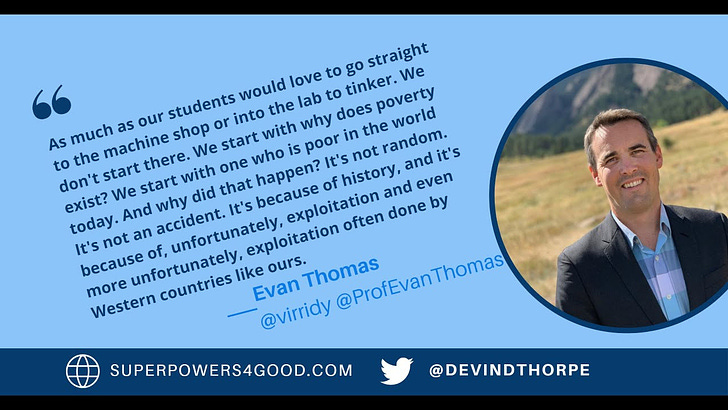



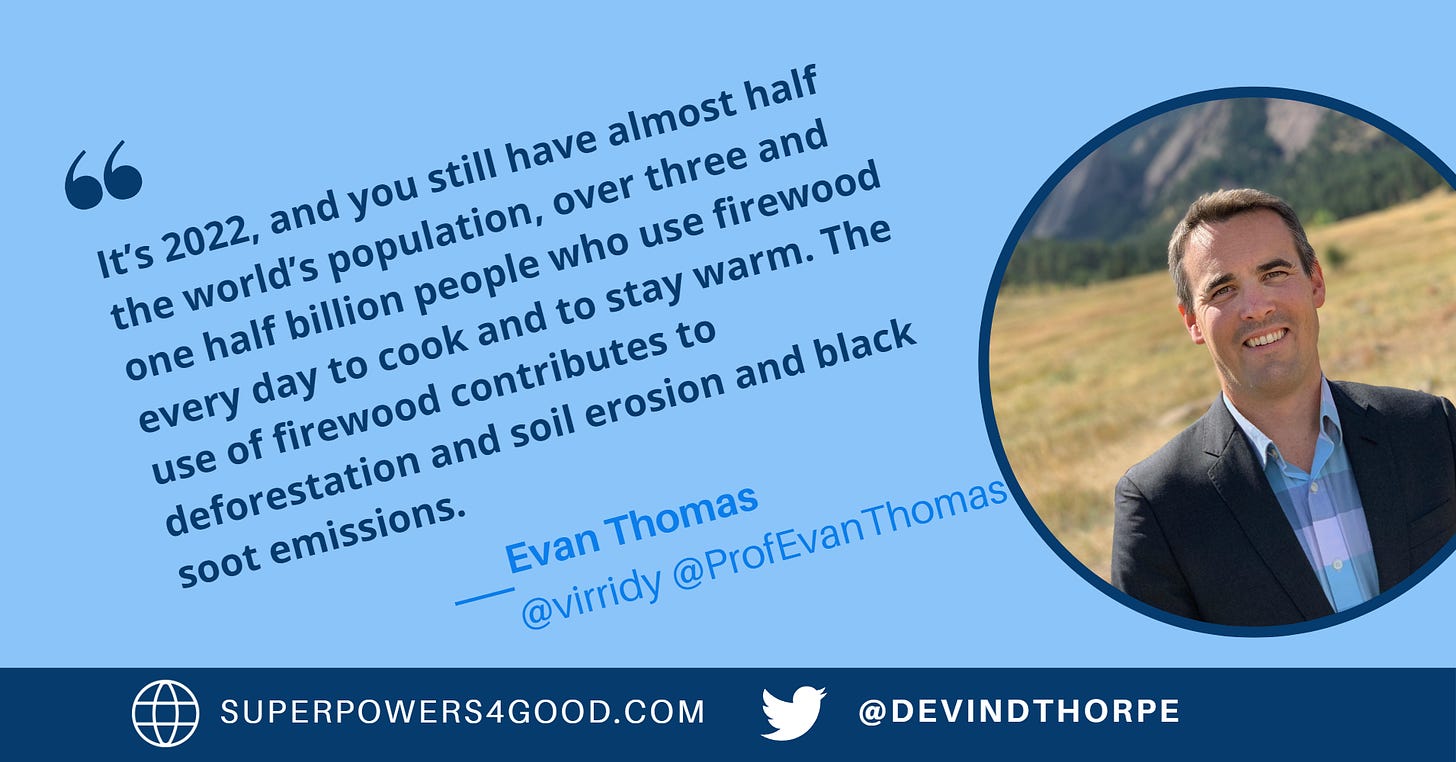

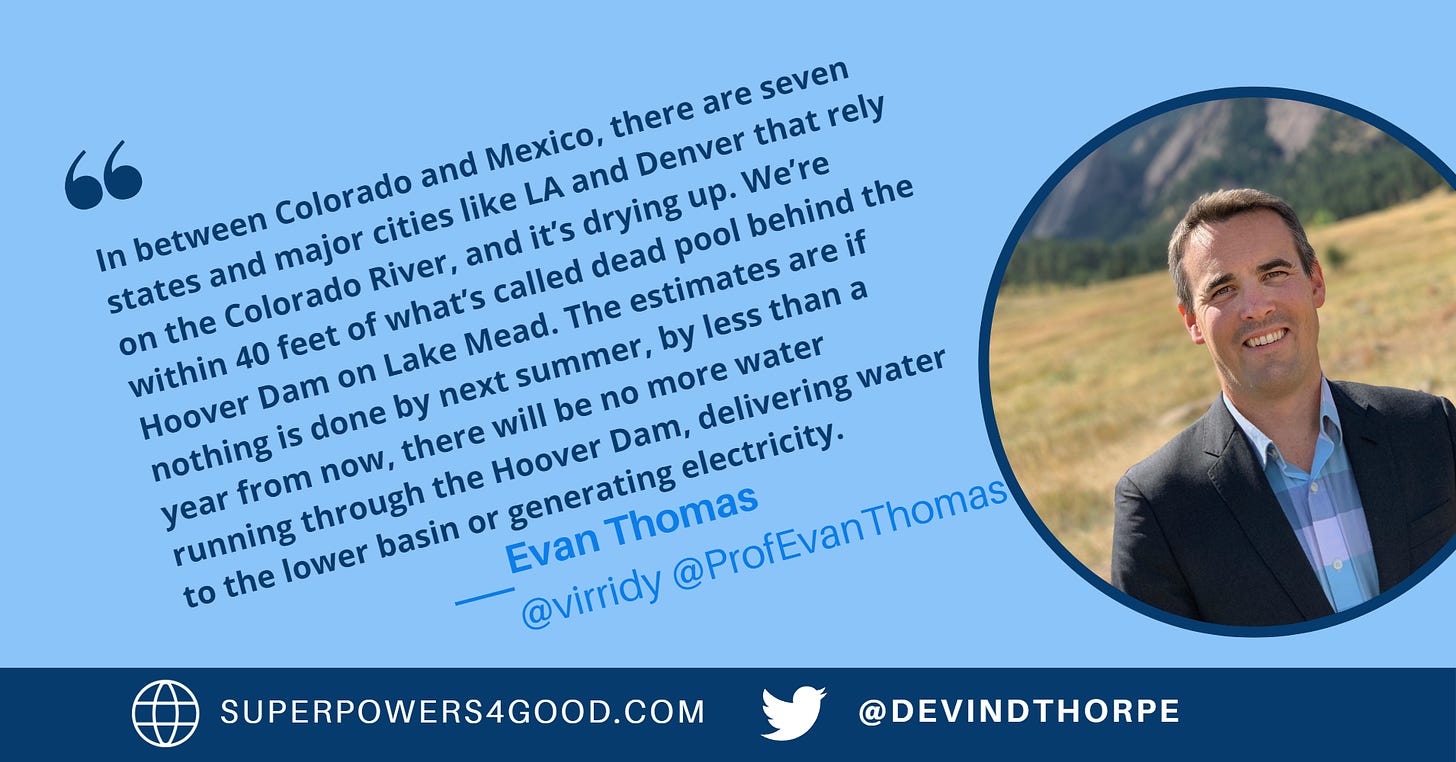
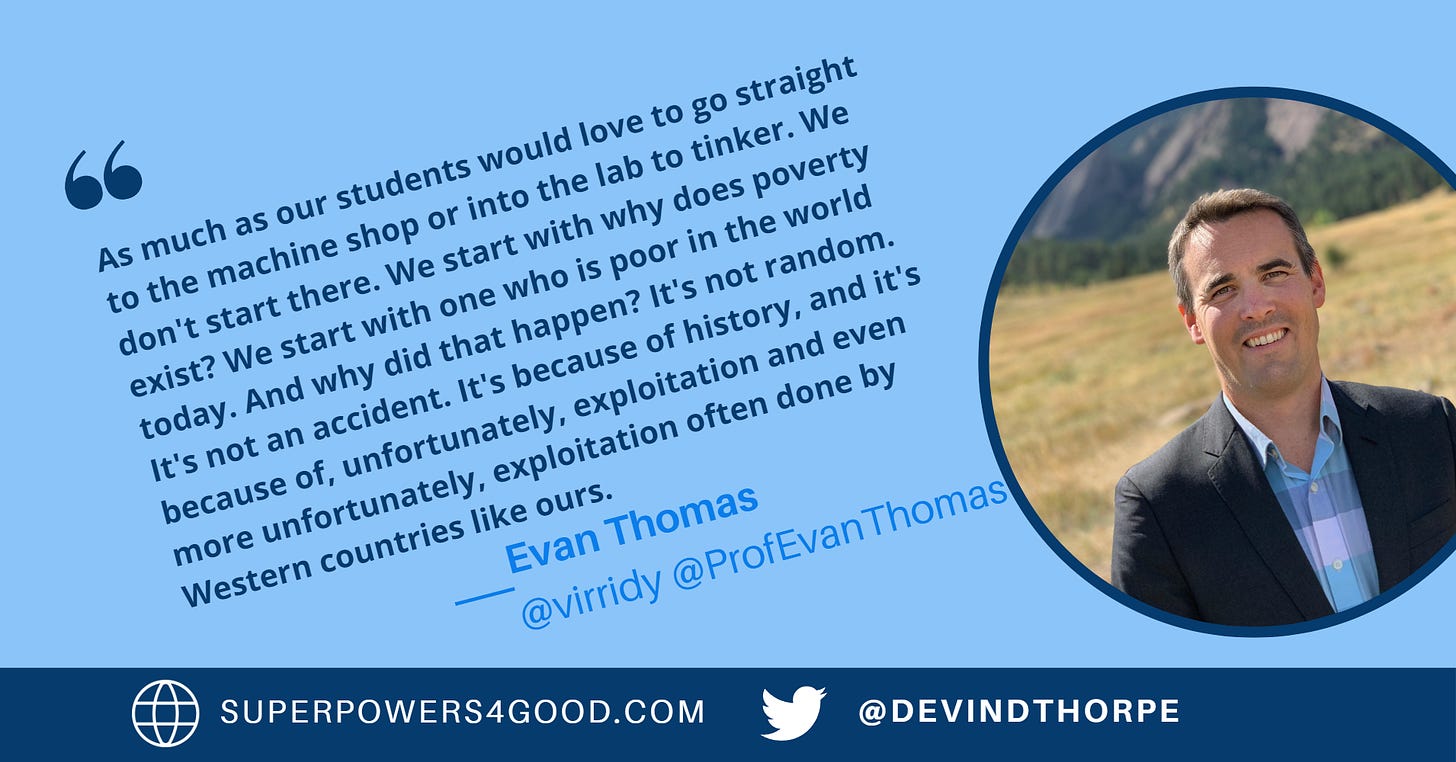














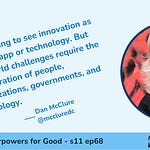




This Aerospace Engineer Brought Tech and Vision to Earthbound Challenges